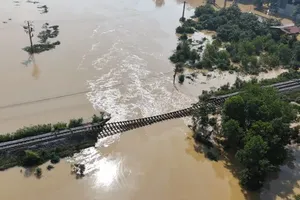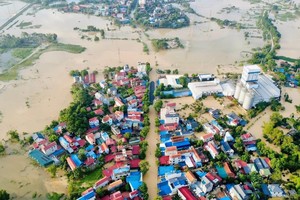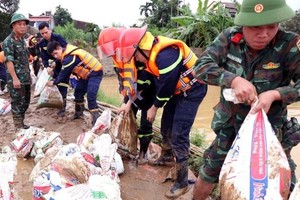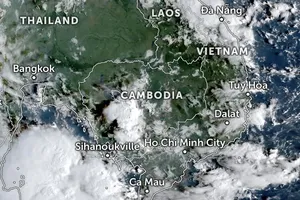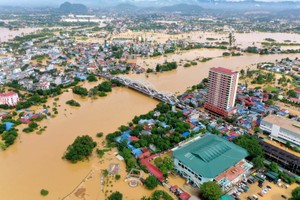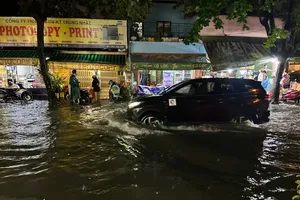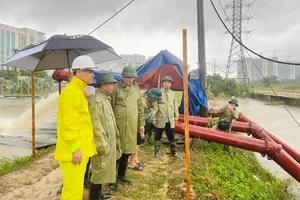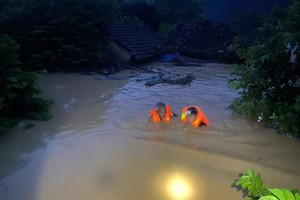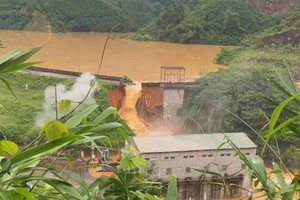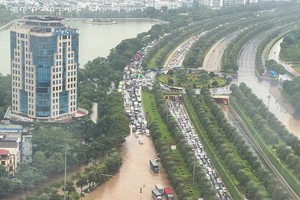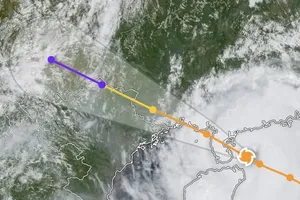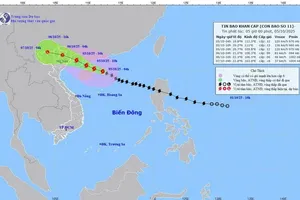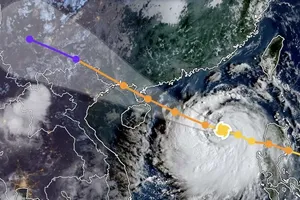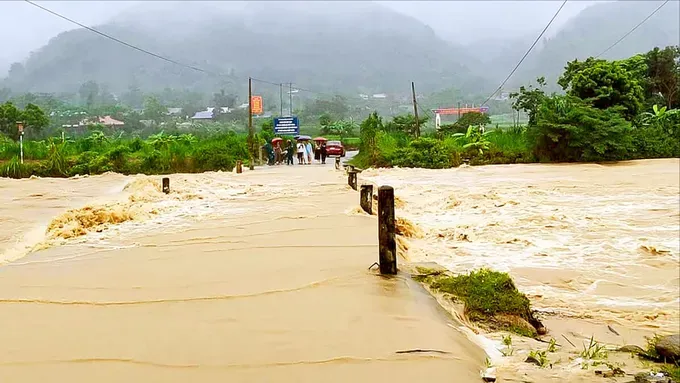
Threat of compounded flooding
In Nghe An Province, the typhoon delivered a devastating one-two punch. With hurricane-force winds, it reportedly swept away 17 houses, tore the roofs from nearly 25,000 homes, and left over 3,900 inundated.
In Thanh Hoa Province, torrential rains have caused severe flooding, cutting off 27 hamlets. The damage to agriculture is catastrophic. Over 90,000 hectares of rice and nearly 15,000 hectares of other crops and fruit trees are submerged. The storm’s fury also downed more than 100,000 trees, damaged 7,000 hectares of forest, and killed or swept away over 11,500 livestock and poultry.
Transportation infrastructure has been paralyzed in many areas, with 216 landslides reported and dozens of roads and bridges flooded or damaged. Air travel was significantly disrupted, with 35 flights canceled and 30 others diverted after the airports of Dong Hoi and Tho Xuan were forced to temporarily cease operations. The power grid suffered a massive blow, with over 1.5 million customers losing electricity and more than 2,650 power poles toppled, primarily in the provinces of Nghe An, Thanh Hoa, and Ha Tinh.
On August 26, the streets of Vinh City in Nghe An Province were a chaotic scene of uprooted trees and downed power lines, causing widespread traffic blockages and communication disruptions. “A tree fell on our roof, and my family, all elderly, couldn’t possibly handle it”, shared local resident 70-year-old Dang Khac Tri. “We were so relieved when the soldiers arrived to help.”
Coastal communes in Ha Tinh Province faced similar devastation, with one restaurant owner at the Xuan Thanh beach resort describing his business as being “in ruins”.
The danger has now shifted. Prolonged, heavy post-typhoon rains are triggering tube floods and landslides, isolating numerous villages in the mountainous regions of Thanh Hoa and Nghe An. In some areas, authorities have had to conduct emergency evacuations. Muong Tip Commune in Nghe An Province, which endured a historic flood just last month, now faces the terrifying prospect of “floods on top of floods”.
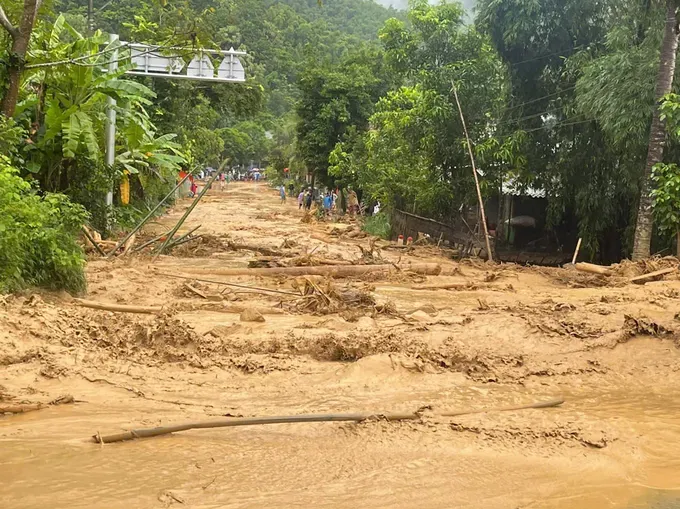
Hanoi: Streets transformed into rivers
Beginning on the afternoon of August 25 and continuing through August 26, Hanoi was pummeled by relentless, torrential rain, leading to deep and widespread flooding. Commuters were forced to wade through inundated roadways that resembled rivers, with water levels reaching halfway up car wheels and, in some places, completely submerging motorbikes. Traffic across the capital came to a standstill.
In the Hoai Duc urban area, with floodwaters reaching nearly a meter deep, opportunistic boat and vehicle-towing services have sprung up, charging residents between VND50,000 – 100,000 (US$2 – 4) for passage. Elsewhere, businesses shuttered as people resorted to homemade rafts to move their belongings. The deluge also brought down a massive, 15-meter-tall mahogany tree near Saint Paul General Hospital, crushing a car whose driver narrowly escaped.
Rainfall in the capital reached a staggering 365mm by the evening of August 26, leading to high water levels in the lakes of Hoan Kiem, Tay Ho, and Truc Bach. The city’s drainage company reported that its system was operating at maximum capacity but was still completely overwhelmed. As of Tuesday evening, many of Hanoi’s streets remained impassable.
In light of the situation, the authorities advised people to proactively prepare response plans to ensure traffic safety and daily life.
At the same time, in the northern mountainous provinces such as Lao Cai and Phu Tho, there was also heavy rain. In Lao Cai, there were landslides in communes and wards such as Sa Pa, Van Ban.
Mekong Delta: Heavy rain, whirlwinds cause landslides
On August 26, the Vinh Long Province People’s Committee issued a decision on the emergency situation of a landslide on the Bac Tra Cu embankment, the section through Luu Cu 1 Hamlet of Luu Nghiep Anh Commune. This section has a 100m long landslide, with a high level of danger, directly threatening the lives and production of the people. In recent days, due to prolonged heavy rain and high tides, the section has collapsed, affecting 81ha of agricultural land, and local traffic may be completely cut off.
In Tay Ninh Province, due to the impact of Typhoon No.5, in the past two days, many places have experienced heavy rain and whirlwinds, causing damage to property and crops of the people. Secretary Nguyen Thi Kim Quyen of the Thanh Dien Ward Party Committee said that a tornado tore the roofs off many houses, some partially collapsed, and many areas of rice, crops, and perennial trees were damaged.
On the same day, the Ca Mau Province Department of Agriculture and Environment said that the West Sea coast section from Tieu Dua to Song Doc has 6 dangerous landslide locations, 250m long, two of which are particularly dangerous with a length of 105m. Currently, the Sub-Department of Irrigation is focusing on handling the particularly dangerous landslide sections.
Prime Minister Pham Minh Chinh issued official Dispatch No.147/CD-TTg, directing authorities to focus on recovery efforts. He has ordered local leaders to safely return evacuated residents where possible, continue moving people from high-risk areas, and, critically, to immediately repair all damaged schools and medical facilities. The goal is to ensure students can return for the start of the new school year in September and that healthcare services are not disrupted.
On August 26, the Ministry of Agriculture and Environment assessed Typhoon No. 5 (international name Kajiki) as one of the strongest and most complex storms in recent years. Before making landfall, it reached Category 14 intensity with gusts up to Category 17, comparable to the devastating Typhoon Yagi of 2024.
Unusually, the storm slowed to a crawl as it neared the coast, lingering over land for a punishing 10 hours, which prolonged the period of destructive winds and led to record-breaking rainfall in several areas. The storm finally weakened over Laos in the morning of August 26.
According to the Ministry of Construction, the storm caused 44 major traffic blockages. The North-South railway line was also severely affected, with several sections closed until early Tuesday morning due to fallen power poles and landslides.
